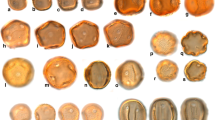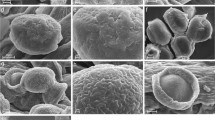Abstract
Pollen morphology of 13 species of the genus Sanguisorba (Rosaceae) was examined by light and scanning electron microscopy. The pollen morphology divided the genus into two main groups: (A) tricolporate with tapered colpus tips, and (B) either tricolporate with opened colpus tip or hexacolporate. The former group was further subdivided into those without vestibulum (A1: S. alpina, S. dodecandra, and S. filiformis) and those with vestibulum (A2: S. agrimonoides, S. ancestroides, S. annua, S. cretica, S. minor, and S. verrucosa), whereas the latter group was subdivided into those with colpus narrow and similar to the A1 type (B1: S. canadensis and S. diandra), those with colpus and mesocolpus somewhat equally wide and forming hexacolporate aperture (B3: S. albiflora, S. armena, S. media, S. menziesii, S. parviflora, S. stipulata, and S. tenuifolia), and those with colpus intermediate between the B1 and B3 types (B2: S. hakusanensis, S. microcephala, S. obtusa, S. officinalis, S. polygama, and S. sitchensis). It is suggested that the A1 type aperture would have evolved to the A2 type as a specialized form and the B types (B1 to B3) in a direction in which the hexacolporate aperture was derived. Implications of pollen morphology for infrageneric classification of Sanguisorba are discussed and the results are compared with molecular phylogenetic studies.









Similar content being viewed by others
References
Abu-Asab MS, Cantino PD, Nowicke JW, Sang T (1993) Systematic implications of pollen morphology in Caryopteris (Labiatae). Syst Bot 18:502–515
Aiton W (1789) Hortus kewensis. III. George Nicol, London
Bawa KS (1980) Evolution of dioecy in flowering plants. Ann Rev of Ecol Syst 11:15–39
Bentham G, Hooker JD (1865) Genera Plantarum. Reeve & Co., London, vol 1
Bertoloni A (1835) Flora Italica. II, add. Bononiae
Brown A, Bouché C (1867) Sanguisorba. Index seminum horti botanici Berolinenesis. Appendix, Berolini
Chung Y, Lee S (1990) A palynotaxonomic study of the Sophora group (Sophoreae, Papilionoideae, Leguminosae). Korean J Pl Taxon 20:257–282
Chung K-S, Elisens WJ, Skvarla JJ (2010) Pollen morphology and its phylogenetic significance in tribe Sanguisorbeae (Rosaceae). Plant Syst Evol 285:139–148
Cooper RL, Osborn JM, Philbrick CT (2000) Comparative pollen morphology and ultrastructure of Callitrichaceae. Am J Bot 87:161–175
Cronquist A (1968) The evolution and classification of flowering plants. Houghton Mifflin, Boston
De Candolle AP (1825) Prodromus systematis naturalis. Regni Vegetabilis, II. Paisiiis
Eide F (1981) Key for northwest European Rosaceae pollen. Grana 20:101–108
Erdtman G (1960) The acetolysis method. Sven Bot Tidsk 54:562–564
Erdtman G (1966) Pollen morphology and plant taxonomy. Angiosperms. Hafner Bubl. Co., New York
Graham A, Nowicke J, Skvarla JJ, Graham SA, Patel V, Lee S (1985) Palynology and systematics of the Lythraceae. 1. Introduction and genera Adenaria through Ginoria. Am J Bot 72:1012–1032
Graham A, Nowicke J, Skvarla JJ, Graham SA, Patel V, Lee S (1987) Palynology and systematics of the Lythraceae. 2. Genera Haitia through Peplis. Am J Bot 74:829–850
Graham A, Nowicke J, Skvarla JJ, Graham SA, Patel V, Lee S (1990) Palynology and systematics of the Lythraceae. 3. Genera Physocalymma through Woodfordia, addenda, and conclusions. Am J Bot 77:159–177
Helfgott DM, Francisco-Ortega J, Santo-Guerra A, Jansen RK, Simpson BB (2000) Biogeography and breeding system evolution of the woody Bencomia Alliance (Rosaceae) in Macaronesia based on ITS sequence data. Syst Bot 25:82–97
Hutchinson J (1964) The genera of flowering plants. vol 1. Clarendon, London
Ikuse M (1955) General survey list of pollen grains in Japan (6). Bot Mag (Tokyo) 30:303–308
Kerr MS (2004) A phylogenetic and biogeographic analysis of Sanguisorbeae (Rosaceae), with emphasis on the Pleistocene radiation of the high Andean genus Polylepsis. Dissertation, University of Maryland, College Park
Kim KH, Lee S (1978) Contribution to the pollen morphology and taxonomy of Korean gymnosperms on the general level. Korean J Forestry 40:35–42
Lee S (1992) Palylnological relationships among Calathodes and its relative genera. Korean J Pl Taxon 22:23–31
Lee S, Blackmore B (1992) A palynotaxonomic study of the genus Trollius L. (Ranunculaceae). Grana 31:81–100
Lee S, Chung Y, Lee C (1993) Palynological relationships between Pectactina rupicola Nakai and its relative taxa. Korean J Pl Taxon 23:149–159
Linnaeus C (1753) Species plantarum. Tomus, vol 1, p 116
Mishima M, Ito M (1996) Phylogeny of Japanese species of Sanguisorba (Rosaceae) based on RFLPs of PCR-amplified cpDNA fragments. Acta Phytotax Geobot 47:195–201
Mishima M, Iwatsubo Y, Horti Y, Naruhashi N (1998) Chromosome numbers in Sanguisorba albiflora (Makino) Makino (Rosaceae). J Jpn Bot 73:76–79
Mishima M, Ohmido N, Fukui K, Yahara T (2002) Trends in site-number change of rDNA loci during polyploidy evolution in Sanguisorba (Rosaceae). Chromosoma 110:550–558
Muller J (1970) Palynological evidence on early differentiation of angiosperms. Biol Rev 45:417–450
Nordborg G (1963) Studies in Sanguisorba officinalis L. Kromosomtalsbestämningar på svenskt maerial. Bot Not 116:266–288
Nordborg G (1966) Sanguisorba L., Sarcopoterium Spach, and Bencomia Webb et Berth. Delimitation and Subdivision of the Genera. Opera Bot 11:1–103
Nordborg G (1967) The genus Sanguisorba section Poterium: experimental studies and taxonomy. Lund Opera Bot 16:1–153
Nowicke JW, Skvarla JJ (1981) Pollen morphology and phylogenetic relationships of the Berberidaceae. Smithsonian Contribution to Botany 50, pp 1–83
Pérez de Paz J (1981) Estudio preliminary del pollen de los generos Macaronesicos Bencomia, Marcetella y Dendriopoterium (Rosaceae: Sanguisorbeae). Bot Macaronesica 8–9:41–58
Pérez de Paz J (2004) Rosaceae-Sanguisorbeae de Macaronesia: Géneros Marcetella, Bencomia y Dendriopoterium. Palinología, biogeografía, sistemas sexuales y filogenia. Bot Macaronesica 25:95–126
Potter D, Eriksson T, Evans RC, Oh S, Smedmark JEE, Morgan DR, Kerr M, Robertson KR, Arsenault M, Dickinson TA, Campbell CS (2007) Phylogeny and classification of Rosaceae. Pl Syst Evol 266:5–43
Punt W, Blackmore S, Nilsson S, Le Thomas A (1994) Glossary of pollen and spore terminology. LPP Contributions Ser. 1. LPP Foundation, Utrecht
Reitsma TJ (1966) Some aspects of the pollen morphology of the genus Sanguisorba L. (Rosaceae). Rev Paleobot Palynol 4:305–310
Scopoli IA (1772) Flora carniolica, I. Vindbonensis
Spach E (1846) Revisio generis Poterium. Annles des Sciences Naturelles 3, Ser. Botanque 5:31–43
Sventenius ER (1948) Estudio taxonómico del género Bencomia. Inst Nac Invest Agron 18(95):1–20
Sventenius ER (1960) Additamentum ad Floram Canariensem. Instituto Nacional de Investigaciones Agrómonicas Ministerio de Agricultura, Madrid
Takhtajan A (1969) Flowering plants: origin and dispersal. Smithsonian Inst Press, Washington
Thorne RF (1968) Synopsis of a putatively phylogenetic classification of the flowering plants. Aliso 64:57–66
Victor JE, Van Wyk AE (2001) Pollen morphology of Euchaetis and Macrostylis (Diosminae-Rutaceae) and its taxonomic implications. Grana 40:105–110
Walker JW (1971) Pollen morphology, phytogeography, and phylogeny of the Annonaceae. Contrib Gray Herb Harvard 202:1–132
Walker JW (1974) Aperture evolution in the pollen of primitive angiosperms. Am J Bot 60:1112–1137
Walker JW, Doyle JA (1975) The bases of angiosperm phylogeny: palynology. Ann Missouri Bot Gard 62:664–723
Webb D, Berthelot C (1836) Historie Naturelle des Isles Canaries. III. 2, Paris
Wen J, Nowicke JW (1999) Pollen ultrastructure of Panax (The ginseng genus, Araliaceae), An eastern Asian and eastern North American disjunctions. Am J Bot 86:1624–1636
Acknowledgments
This paper represents partial fulfillment of an MS degree in Biological Education for the third author (J.C.), submitted at Sungkyunkwan University. We thank two anonymous reviewers for their helpful comments and suggestions on an earlier draft of the manuscript.
Author information
Authors and Affiliations
Corresponding author
Rights and permissions
About this article
Cite this article
Lee, S., Heo, Ki., Cho, J. et al. New insights into pollen morphology and its implications in the phylogeny of Sanguisorba L. (Rosaceae; Sanguisorbeae). Plant Syst Evol 291, 227–242 (2011). https://doi.org/10.1007/s00606-010-0384-0
Received:
Accepted:
Published:
Issue Date:
DOI: https://doi.org/10.1007/s00606-010-0384-0




